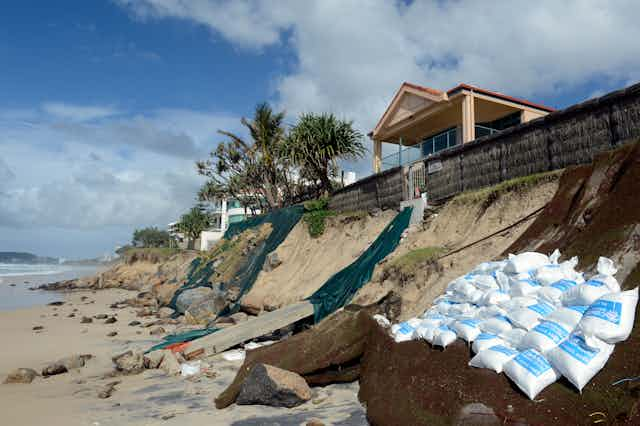Coastal management in Australia is subject to competing interests and challenges. These range from land use and strategic planning issues to ecosystems preservation. Local councils are at the coalface as both key decision-makers and the first point of contact for communities.
Exacerbating these day-to-day challenges for councils are risks to property. A quantitative assessment undertaken by the then-Department of Climate Change in 2009 identified impacts of sea-level rise as a serious threat to property.
In New South Wales, under scenarios of a 1.1-metre sea-level rise, risks of damage or inundation to residential housing alone affected tens of thousands of properties, potentially costing millions of dollars. The NSW 2009 sea-level rise policy (now repealed) saw coastal councils considering this future risk when developing coastal zone management plans.
These metrics, while important, say little of the wide-ranging benefits of a freely accessible coast. Going to the beach is a fundamental part of Australian identity; it’s a “special place” for Australians.
Local councils are most exposed to the issues and challenges of a changing coastline in which there are many interests. Councils are often the first decision-makers for local development, asset management and land-use and strategic planning. Increased coastal erosion, storm events, more frequent and severe flooding impacts and higher tides can and will make these regular functions of councils more complicated.
In this context, the tabling of the NSW Coastal Management Bill on May 3 marks the formalisation of Stage 2 of the most significant law reform to coastal management since the 1970s. The NSW state government says that, by better integrating coastal management with land-use planning, the legislation offers:
… a modern, coherent coastal management framework that is responsive to current needs and future challenges.
Property rights hold sway
Despite a prominent focus on property values when it comes to coastal management issues, including climate adaptation, evidence is emerging that residents are attached to their property for more than financial reasons.
Private property interests often take priority as councils attempt to balance competing interests. An example of this is ongoing litigation over a sandbag wall on Belongil Beach in Byron Bay.

After a series of severe coastal storms in the 1970s, Byron Shire Council adopted a policy of “planned retreat”. The location of this small northern NSW community on the most easterly point of Australia means it is already exposed to coastal hazards. These will become more frequent and more severe under future climate scenarios.
The planned retreat policy set requirements for the future relocation of private property. Local property owners, particularly those with beachfront property, have vehemently opposed the use of the policy to prevent coastal property protection.
In May 2009, a particularly severe coastal storm caused significant damage to private residential property and the beach. Beachfront property owners (the Vaughans) sought to reinstate council-approved sandbag protection works on their property. This sandbag wall had collapsed during the storm.
The Vaughans sued the council and the council sued the Vaughans. This particular matter settled in February 2010 and the failed sandbag wall has been reinstated.
More recently, council plans to install a permanent rock wall at the same location ran into fierce opposition from the community, for whom the public amenity of the beach is critical, and legal challenges.
This example highlights some critical aspects of coastal management:
private property rights are deeply entrenched in Australian culture and legal systems
climate adaptation is easier when it comes to future development
recourse to litigation in protecting your property is much easier if you can afford it.
Climate adaptation planning, including planned retreat, can be more easily implemented for future development. There are excellent examples of local government in NSW providing landowners with a range of development options.
NSW reforms weigh future risks
Much of the coast of Australia, however, is already developed. The residential development includes affordable housing options. To balance competing interests along the coast, all members of coastal communities must be considered.
To this end, the NSW bill, if passed, would lead to a new Coastal Management Act, a new Coastal Management State Environmental Planning Policy and a coastal management manual. Together these advance a more forward-thinking coastal management response. This has a central focus on ecologically sustainable development that can better balance both the management of coastal hazards and the integrity of the coast.
Local councils will be responsible for implementing these new legal requirements. Under Part 3 of the Coastal Management Bill, councils will be required to monitor coastal hazards and to give effect to coastal management plans. It would appear this includes future sea-level rise.
As has been advocated in numerous policy reports, the councils can’t do this alone. They need assistance from the federal government as well as the state.

